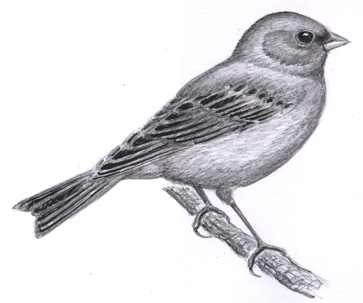
Dear Bird Folks:
Last week I had the cutest little bird under my feeder. It was solid blue, about the size of a chickadee. My bird book suggests that it was either an Eastern Bluebird, a Blue Grosbeak or an Indigo Bunting. Do you have any suggestions as to which it was and will it stay in my yard all summer?
-Brenda, Mashpee
Cool Brenda,
A multiple choice quiz. First let me get a #2 pencil, clear the books off of my desk, put my feet flat on the floor and keep my eyes forward. Now, what was your question again? Oh yeah, something about an all blue bird. Let’s see, your mystery bird couldn’t be either an Eastern Bluebird or a Blue Grosbeak, because, in spite of their names, neither of those birds are all blue. According to your clue, the mystery bird was “solid blue”. Plus, both of those birds are larger than a chickadee. That leaves us with a clear winner. The answer to your question is C.) Indigo Bunting. But here is the odd part, the bird that you saw, the Indigo Bunting, isn’t blue at all or even indigo, it is black. Really. Calm down, I’ll explain that in a minute.
Here on Cape Cod, Indigo Buntings are a spring time treat. In April and May we get lots of calls from lucky people who are finding blue looking mystery birds under their feeders. The curious thing is that just about everywhere else, Indigo Buntings are common, just not on Cape Cod. Nobody else gets excited about them but us. Their summer range runs from the East Coast, west to Texas and all of those rectangle shaped states. Even Massachusetts has plenty of them. They are common throughout our entire state, except for the Cape. Buntings apparently can’t handle all of the rotaries.
Like many spring birds, Indigo Buntings spend the winter way down in the tropics and need to make the long migration north to their breeding grounds. It is speculated that strong winds sometimes force migrating birds to fly over the ocean. (Pay attention here Brenda, this is important.) The migrating buntings, that are trying to get to any place but Cape Cod, are forced by the winds, to land here. These tired and hungry birds chow at our feeders, which is interesting, since feeder visits aren’t all that common once nesting begins. Then, after a quick stop for refueling, the buntings move on.
The breeding plumage male Indigo Bunting is the striking solid blue that everyone gets excited about. The female bunting on the other hand is generic drab brown and will often go unnoticed. I’d bet most people pass the female off as some kind of sparrow, but this bird is even dull for a sparrow. (I can’t say duller than C-SPAN anymore, some lady yelled at me for writing that last week.)
The Male bunting is a typical pretty boy male. When it comes to the domestic chores (you’re not going to like this Brenda), he is basically old school. He does none of the nest building, nor does he help incubate the eggs or feed the baby birds. He just sits high upon an exposed branch, looking studly, while the female does all of the “woman’s work” (his words, not mine). However, once the young birds have fledged, he does take over the feeding chores and finally becomes a good father. But that is only so the female can get started on a second brood.
Now to expound on a subject that I touched upon earlier. The Indigo Bunting is not blue at all, but black, black as coal. How can this be, when your eyes are clearly seeing that the bird is blue? The red on a cardinal, for example, is from the red pigment on the bird’s feathers. But there are no blue pigments on the bunting’s feathers. The blue that we see is the result of “feather structure”. The feathers are formed in such a way that the reflecting light makes them appear blue. When the sun is shining down on the bird, it looks very blue. But, if the sunlight is coming from behind, the bird looks black. Confused? I know, I don’t get it either, but that’s what the books say.
Enjoy the buntings now Brenda, because by June most will be gone. Perhaps some day they will decide to start nesting here, but probably not until we get rid of the rotaries.